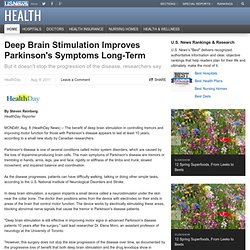

Deep Brain Stimulation Improves Parkinson's Symptoms Long-Term. By Steven ReinbergHealthDay Reporter MONDAY, Aug. 8 (HealthDay News) -- The benefit of deep brain stimulation in controlling tremors and improving motor function for those with Parkinson's disease appears to last at least 10 years, according to a small new study by Canadian researchers.

Parkinson's disease is one of several conditions called motor system disorders, which are caused by the loss of dopamine-producing brain cells. The main symptoms of Parkinson's disease are tremors or trembling in hands, arms, legs, jaw and face; rigidity or stiffness of the limbs and trunk; slowed movement; and impaired balance and coordination. As the disease progresses, patients can have difficulty walking, talking or doing other simple tasks, according to the U.S. Expert Consensus on Deep Brain Stimulation in Parkinson's Published.
Deep brain stimulation. Deep brain stimulation (DBS) is a surgical treatment involving the implantation of a medical device called a brain pacemaker, which sends electrical impulses to specific parts of the brain.

DBS in select brain regions has provided therapeutic benefits for otherwise-treatment-resistant movement and affective disorders such as Parkinson's disease, essential tremor, dystonia, and chronic pain.[1] Despite the long history of DBS,[2] its underlying principles and mechanisms are still not clear.[3][4] DBS directly changes brain activity in a controlled manner, its effects are reversible (unlike those of lesioning techniques), and it is one of only a few neurosurgical methods that allow blinded studies.
[citation needed] Components and placement[edit] All three components are surgically implanted inside the body. Lead and extension implantation may take place under local anesthesia or with the patient under general anesthesia ("asleep DBS").